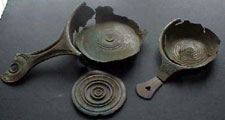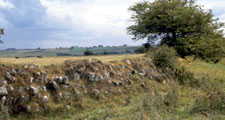Roman
(AD70 – C5)
The agricultural landscape probably changed little during the Roman occupation. Having conquered the native Brigantes around 80 AD, the Romans built Dere Street as their supply route from York to the Firth of Forth. The road remained in continuous use throughout the Roman period and, as Durham was then a frontier territory, a number of forts were built along its length. Around 120 AD, having failed to subdue the inhabitants further north, they built Hadrian’s Wall stretching 117 km (73 miles) from the mouth of the River Tyne in the east to the Solway Firth in the west. Having established this frontier, the more fertile terrain of mid Durham to the south became important for provisioning and leisure, and the mining of coal and metal ores.
The principal impact of the Romans on the landscape of the County lies in the great roads like Dere Street and Cades Road, many of which are still in use today, and in the settlements that developed from their camps including Ebchester, and Lanchester and Rey Cross. Notable physical remains include the fort and bath house at Binchester and the forts at Lanchester and Rey Cross on the A66.



